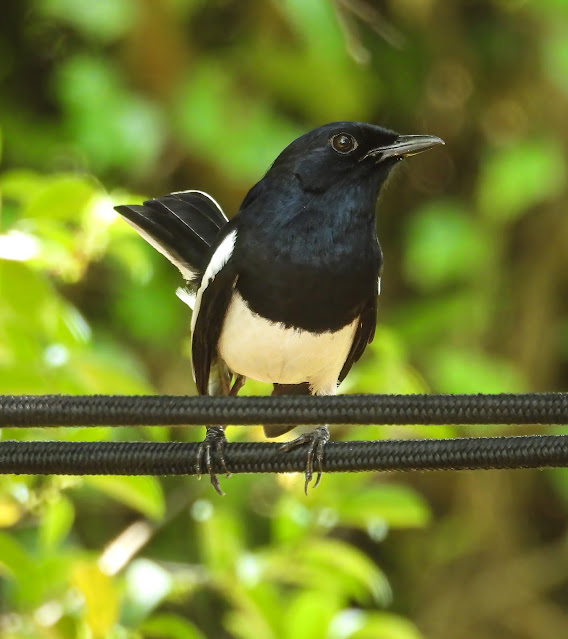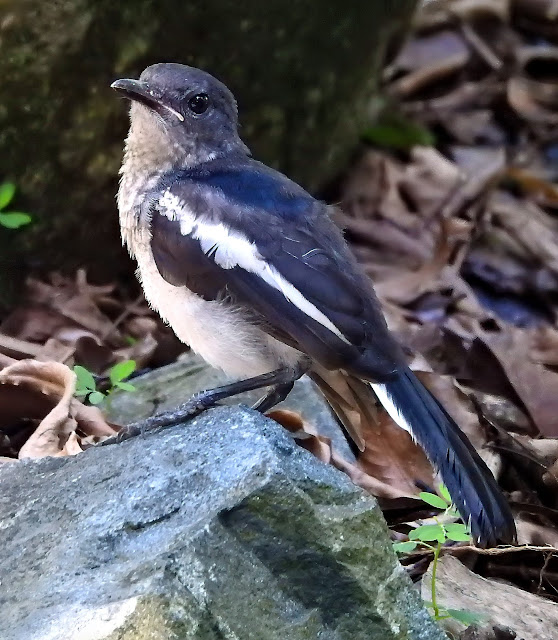The Oriental magpie-robin (Copsychus saularis) is a small, striking passerine bird, once grouped with thrushes but now classified among the Old World flycatchers. Males are characterized by their black upperparts, head, and throat, contrasted with a white shoulder patch and white underparts extending to the sides of their long tail. Females, on the other hand, display a more subdued greyish black above and greyish white below. Juveniles bear scaly brown upperparts. This species is known for its long tail, typically held upright, and its melodious song, which has made it a favored cagebird in the past.The Oriental magpie-robin measures about 19 centimeters in length, including its distinctive long tail. The male's black and white plumage and the female's greyish tones are key identification features. The tail is often cocked upright when the bird is active on the ground, but it assumes a normal position during singing.
These birds are adaptable and can be found in a variety of habitats, from urban gardens to forests. They are often seen close to the ground, foraging in leaf-litter or perching conspicuously.
The Oriental magpie-robin is widespread across the Indian subcontinent and parts of Southeast Asia, including Nepal, Bangladesh, India, Sri Lanka, Pakistan, Indonesia, Thailand, China, Malaysia, and Singapore.
Magpie-robins are territorial, especially during the breeding season when males sing from high perches. They are known to be aggressive in defending their territory and may even respond to their own reflections. Their foraging behavior includes hopping along branches and rummaging through leaf-litter.
The Oriental magpie-robin is celebrated for its varied and melodious song, which includes imitations of other bird species. Calls range from territorial to distress signals, with a distinctive harsh mobbing call sounding like a hissing 'krshhh'.
Breeding season varies by region, with nests typically found in tree hollows or wall crevices. The female is primarily responsible for nest building and incubation, which lasts 8 to 14 days. Eggs are pale blue-green with brown speckles, and clutches usually consist of four to five eggs.
While there are no very similar species within its range, the Oriental magpie-robin can be confused with the Philippine magpie-robin (Copsychus mindanensis), which is now recognized as a separate species.
Primarily insectivorous, the Oriental magpie-robin's diet consists of insects and other invertebrates, though it may occasionally consume nectar, geckos, leeches, centipedes, and even small fish.
The IUCN lists the Oriental magpie-robin as Least Concern, but its populations are declining in some areas due to habitat loss, competition from other species, and trapping for the pet trade. They are protected by law in some regions.
The Oriental magpie-robin holds cultural significance in various countries. It is the national bird of Bangladesh, known locally as the doyel or doel, and is a symbol of pride, appearing on currency and in public squares. In Sri Lanka, it is called Polkichcha, and in southern Thailand, it is known as Binlha, often featured in local songs.






















%2020.jpg)
%2020.jpg)
%2021.jpg)
%2023.jpg)
%2024.jpg)
%2025.jpg)
%2026.jpg)
%2020.jpg)
%2020.jpg)
%2030.jpg)
%2031.jpg)
%2020.jpg)